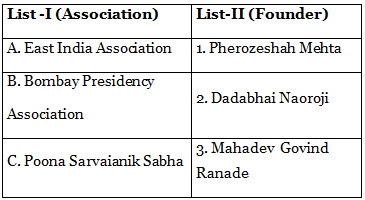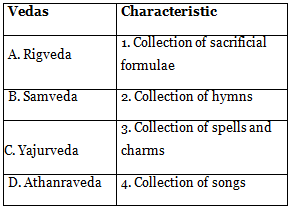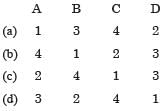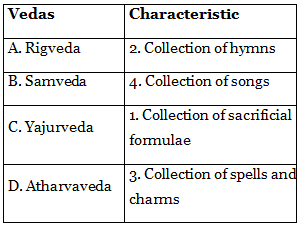Test: History & Culture - 4 - UPSC MCQ
30 Questions MCQ Test - Test: History & Culture - 4
Consider the following literary works
1. Abhigyanshakuntalam
2. Meghdoot
3. Raghuvamsa
Q. Which of the following books is/are written by Kalidasa?
Match the following:

Select the correct answer using the code given below:


Select the correct answer using the code given below:

| 1 Crore+ students have signed up on EduRev. Have you? Download the App |
Consider the following statements regarding the village life under Mughal rule:
1. Kamins were the landless peasants who often belonged to the untouchable class.
2. Khudkasht were the peasants who owned the land they tilled.
3. Muzarain were the tenants who paid land revenue at higher rates as compared to other classes of peasants.
Q. Which of the above statements is/are incorrect?
1. Kamins were the landless peasants who often belonged to the untouchable class.
2. Khudkasht were the peasants who owned the land they tilled.
3. Muzarain were the tenants who paid land revenue at higher rates as compared to other classes of peasants.
Consider the following statements regarding ‘Doctrines of Jainism’:
1. Principle of Syadavada is also known as the doctrine of non-one-sidedness.
2. Principle of Anekantavada emphasises on the relativity of all knowledge.
3. Principle of Pancha Mahavrata deals with the 5 great vows of a Jaina.
Q. Which of the above statements is/are correct?
Consider the following statements related to the Lucknow pact of 1916:
1. While the League agreed to present joint constitutional demands with the Congress to the government, the Congress accepted the Muslim League’s position on separate electorates.
2. The Muslims were also granted a fixed proportion of seats in the legislatures at all-India as well as at provincial levels
Q. Which of the above statements is/are correct?
Match the following:

Select the correct answer using the code given below:

Consider the following statements regarding the Simon Commission:
1. It had the objective of studying the progress of governance schemes.
2. It had an equal number of Britishers and Indians as a member.
3. It proposed the abolition of DYARCHY.
Which of the above statements are correct?
‘Mohammad Bin Tughlaq was known as an ill-fated idealist’. In this context consider the following events that occurred during his reign:
1. He is known to have transferred his capital from Delhi to Devagiri.
2. He issued copper coins at par with the value of the silver tanka coins.
3. Ibn Batuta acted as a Qazi in Delhi for eight years during his reign.
4. Fort of Adilabad was built under his rule.
Q. Which of the above statements are correct?
Which of the following statements is/are correct regarding Satyagraha Sabha?
1. It was formed by Gandhiji at Bombay.
2. It was launched against the Government of India Act,1935
Select the correct answer using codes given below:
Consider the following statements regarding the later Vedic polity:
1. It was a monarchical system.
2. It gave greater stress on hereditary rulership.
3. Vidatha replaced Sabha and Samiti as the popular assembly to check the king’s authority.
Q. Which of the above statements is/are correct?
With reference to the British Indian Government’s attitude towards the Indian National Congress, consider the following statements:
1. The government encouraged Sir Syed Ahmad Khan to form the United Indian Patriotic Association to counter Congress propaganda.
2. Lord Dufferin called Congress “a factory of sedition”.
Q. Which of the above statements is/are correct?
With reference to the religious policy of Akbar, consider the following statements:
1. Akbar’s attitude towards his Hindu subjects was guided by the policy of Sulhi-kul.
2. The proceedings at Ibadat Khana were initially confined to Muslims only.
3. Akbar propounded Tauhid-i-Ilahi which combined elements from other existing religions.
Which of the above statements is/are correct?
Which of the following correctly describes the findings of Megasthenes’s Indica?
1. There were no slaves in India during the gupta period.
2. The Pandyas were first mentioned by Megasthenes.
3. The king was at the head of the government and assisted by a council of ministers.
4. The administration of the armed forces was carried on by a board of thirty officers divided into six committees.
Select the correct answer using the code given below:
The British Government decided to send a high-powered commission of three members in February 1946 to India. Who among the following was/were the members of this commission?
1. Clement Attlee
2. Stafford Cripps
3. A.V. Alexander
4. Leo Amery
Select the correct answer using the code given below:
With reference to the Swadeshi Movement, consider the following statements:
1. National education attracted the bulk of the student community.
2. Nationalist interest in labour slumped suddenly during Swadeshi movement
3. The sudden emergence of the samitis or ‘national volunteer’ movement was one of the major achievements of this movement
Which of the above statements are correct?
Consider the following statements:
1. Pitt’s act 1784 called the Company’s territories as the British Possessions in India.
2. The Act of 1786 provided that the entire burden of the expenses of the Board of control and their staff should be on the Indian revenues.
3. The Charter Act of 1793 allowed Governor-general to override the council’s decision.
Which of the following statements is/are correct?
Which of the following statements is/are correct with regard to the Henry Vivian Derozio?
1. He was the leader of Theosophical society.
2. He supported the ideas of radicalism, liberty, equality and freedom, and opposed the decadent customs and traditions.
Select the correct answer using the code given below:
Which of the following statements is/are correct regarding Nehru Report?
1. A subcommittee was appointed under the chairmanship of Jawaharlal Nehru to draft a constitution.
2. This was the first major attempt by the Indians to draft a constitutional framework for the country.
Select the correct answer using the code given below:
Who among the following were jailed in the Kanpur Bolshevik conspiracy case in 1924?
Consider the following statements regarding Jinnah’s “Fourteen Points”.
1. It demanded full liberty of belief and worship for the Muslim community only.
2. It aimed for at least one fourth Muslim representation in central legislature.
3. It proposed the creation of a federal structure with residuary powers vested in the provinces.
Q. Select the correct answers using the codes given below:
Consider the following statements regarding the Poona Pact, 1932.
1. It provided for reservation of Dalits in Central legislative assembly and provincial assemblies.
2. In education grants of state, due consideration was to be given for promotion of education among
depressed classes.
3. The pact was signed between Dr. B.R. Ambedkar on behalf of Harijans and Mahatma Gandhi on
behalf of Indian National Congress.
Q. Select the correct statement/s using the codes given below.
Consider the following Statement
1. Indian social conference was founded by Bal Shastri Jambdekar and K. Kesava.
2.It worked as a social reform cell of the Indian national congress.
3.It merged with theosophical society later in 20th century.
Which of the following statements is/are correct?
British Government appointed an Indian Statutory Commission to review the Government of India Act 1919, this commission is also known as?
With reference to the Stone Age culture in India, consider the following statements:
1. The lower Paleolithic tool technology is characterized by flake tool industry.
2. Middle Paleolithic tools have mostly been found in Northern India.
3. Microliths are the tools of Mesolithic age characterized by parallel-side blades.
Q. Which of the above statements is/are correct?
Which among the following laws and commissions set up by Britishers can be considered as an achievement of the Moderates?
1. Welby Commission
2. Aitchison Commission
Q. Select the correct answer using the codes given below:
Consider the following statements regarding Simon Commission.
1. It was constituted to review the working of Indian Council Act, 1909
2. It was an all-white commission, making Indians to resent against it.
3. The recommendations of Simon Commission form the basis of the Govt of India Act, 1935
Q. Select the correct answer using the codes given below:
Select the incorrect statement from the sentences given below
Consider the following statements regarding revolt of naval ratings.
1. It started against the biased treatment of non-commission India Navy officers
2. The mutiny was led by B.C. Dutt .
Q. Select the Incorrect answer using the codes given below:
Which among the following events are associated with the tenure of Lord Ripon?
1. Appointment of Hunter Commission
2. Illbert Bill controversy
3. Factory Act, 1881
4. Local Self Government
Q. Select the correct answer using the codes given below:
Consider the following reasons which played role in conflict between Britishers and Bengal Nawab Siraj – ud – Daulah Khan.
1. Misuse of Dastaks (passes) by Britishers.
2. Levying of heavy taxes on Indian goods entering Calcutta by Britishers
3. Fortification of Chandernagar at Calcutta by Britishers .
Q. Select the correct statement/s using the codes given below:



















